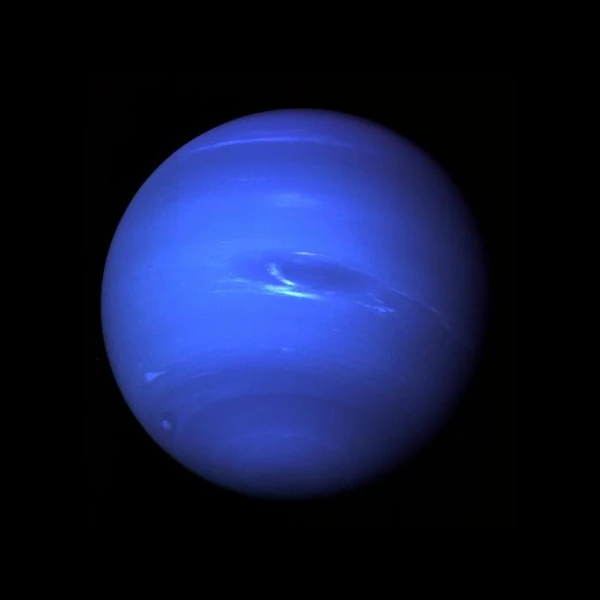
Image: Photograph sent by Voyager 2, this stunning image of storms in the windy atmosphere of Neptune was taken on August 24, 1989. Image Credit: NASA.
Neptune is the eighth and last planet in the solar system, located at an average distance of 4.5 billion kilometers from the Sun.
• Size and mass: Neptune has a mass of about 1.02 x 10^26 kg, or about 17.2 times that of Earth. Its size is also remarkable, with a diameter of 49,244 km, or about 3.9 times that of Earth.
• Atmosphere: Neptune's atmosphere is mostly hydrogen (about 80%) and helium (about 19%), with traces of methane, ammonia, and water. The presence of methane in Neptune's atmosphere gives the planet a blue color similar to that of Uranus.
• Great Dark Spot: Like Jupiter, Neptune also has a "Great Dark Spot" which is a massive storm in its atmosphere, although Neptune's storm is smaller and less active than Jupiter's.
• Rings: Neptune has tenuous and weak rings, similar to those of Uranus. They are mostly made up of dust and rocks rather than ice.
• Magnetosphere: Neptune's magnetic field is about 27 times stronger than Earth's, but it is also tilted relative to the planet's axis of rotation. This tilt gives rise to a complex magnetosphere that changes over time.
• Satellites: Neptune has 14 known satellites, the largest of which are Triton, Nereid, Naiad and Thalassa. Triton is notable for its retrograde orbit, which means it orbits in the opposite direction to Neptune's rotation.
• Orbit: Neptune orbits the Sun at an average distance of about 4.5 billion km, or about 30 astronomical units.
• Internal Composition: Neptune's internal composition is mostly water, ammonia, and methane in the form of ice, with a rocky, metallic core. The pressure and temperature inside the planet are high enough for these substances to be compressed into a liquid metallic form.
Neptune (Poseidon in Greek, god of the sea) is the 8th and last planet of the solar system and only reveals itself with powerful instruments. It is at an average distance of 4,553,946,490 km from the Sun, (30 times farther than the Earth), its revolution around the Sun lasts 164 years and 280 days, at the speed of 5.45 km/s. Learn more.
Definition of the word planet (August 24, 2006):
"A planet is a celestial body which is in orbit around the Sun, which has sufficient mass so that its gravity overcomes the cohesive forces of the solid body and maintains it in hydrostatic equilibrium (spherical shape), and which has eliminated any body moving in a near orbit".